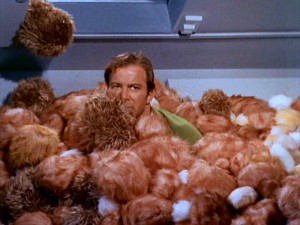In 1964, Arthur C. Clarke called the replicator “the invention to end all inventions.”
Just a few years later, the replicator became a staple on Star Trek, providing the crew with food, water, spare parts, and later on, breathable air.
“Don’t ask me exactly how the replicator would work–if I knew, I’d patent it at once,” said Clarke.
In theory, replicators, or “molecular assemblers” can arrange subatomic particles into molecules, and then arrange the molecules into objects. This means that the first step in the creation of almost anything would be for the replicator to form atoms like carbon or hydrogen, and then arrange them into cells, proteins, and other DNA or matter-composing molecules, and then put the particles together like a really complicated jigsaw with a billion tiny pieces that incredibly end up looking like a clock or a carrot, or a thousand-dollar bill.
Because these replicators would have to be able to produce any one of a number of materials at a given time, they would have to store a staggering amount of patterns. Because not even the cloud has enough room for all this data, replicators would have to store patterns in molecular memory. While that alleviates the space issue, it makes replicating more complicated objects, including people, impossible. Except when aliens replicate Picard, but that’s another story.
In 1992, nanotechnologist Eric Drexler proposed the idea of a “nanofactory,” a system in which nanomachines–the replicators–arrange certain molecules to catalyze reactions, from which larger atomic parts could be built and then eventually assembled into objects. Essentially, you feed bits into a nanofactory, and out pops an “atomically precise part.” Nothing could be easier.
Here’s a colorful demonstration of how this works.
Drexler’s theory has been expanded upon and refined by numerous scientists. In 2000, 23 scientists from 4 countries founded the Nanofactory Collaboration, which focuses specifically on the replication of “diamondoids” through a process called mechanosynthesis. Diamond mechanosynthesis involves catalyzing a chemical reaction in a molecule. Then, a mechanical device such as a computer adds or removes atoms from a surface to form covalent bonds. The computer control offers such precision that reactions can be caused one atom at a time all along a surface.
The construction of a nanofactory is thought to have four parts: molecular position fabrication, programmable positional assembly (the atomically precise assembly of the molecules fabricated in mechanosynthesis), massively parallel positional assembly (the assembly of not just one, but many—even trillions—of anatomically precise parts), and nanomechanical design (simulation, design and manufacture of the actual object).
Scientists have worked on all four aspects, but right now, most research is devoted to proving the theoretical and experimental feasibility of mechanosynthesis.
Ralph Merkle, a leading expert in nanotechnology, says that the replicator is coming. There is nothing in the laws of physics that would prevent us from arranging atoms in a particular way, and theoretical and experimental research supports this claim. All we have to do, he says, is “control the structure of matter” and “build molecular structures where everything is where you want it.” Well, that sounds easy, doesn’t it?
Scientists can arrange molecules on a surface, but haven’t yet mastered the ability to stack them or arrange them into 3-D objects. Merkle estimates that functioning nanofactories are anywhere from 20-40 years away, depending on how much scientists focus on their development.
I know what you’re thinking–as soon as we master replication, what’s to stop us from self-replicating? Why stop at one diamondoid when you can simply have a diamond self-replicate infinite times? How about a hunk of cheese that self-replicates so that we never have to settle for plain bread or naked crackers ever again? Why not populate the earth with dozens of smiling versions of ourselves?
While work on self-replicating machines is underway (and a topic for a forthcoming post), self-replication is much more difficult to achieve than replication. A self-replicator would have to build a system that could then build more systems by itself, with no human intervention. A self-replicator would have to be able to produce and reproduce every tool needed in the process over and over, which right now is a bit like putting the cart before the horse.
There are plenty of ethical debates about whether we should pursue nanofactories, and nanotechnology in general. Nothing would have much value, given that objects could simply be produced infinitely and presumably made available to anyone. The economic implications are mind-boggling, in addition to the moral ones—what happens to a society in which the emotional, situational, spiritual, and sentimental value of all objects is negligible?
“Cynics may doubt if any human society could survive an invention which would lead to unlimited abundance and the final ending of the curse of Adam,” says Clarke.
Only time will tell, but here’s one fact to set your minds at ease now: the trouble with Tribbles wasn’t due to use (or misuse) of a replicator–those little buggers multiply of their own frisky accord, which means that we’re safe. For now.


